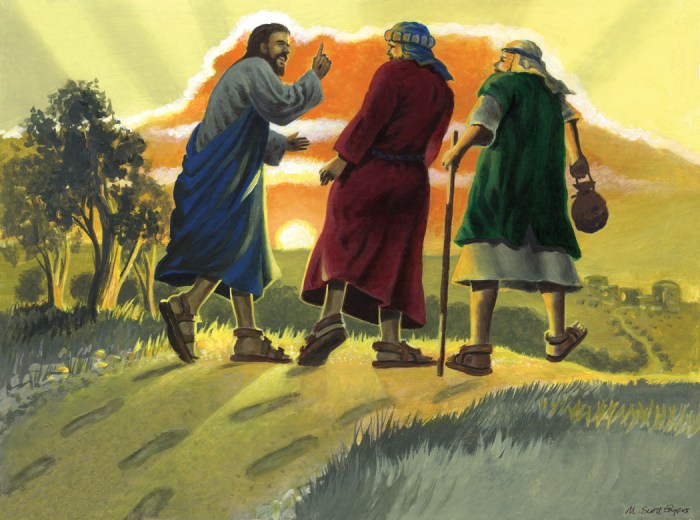Embark on an exploration of the “Road to Emmaus Bible Study Questions,” a captivating narrative that delves into the transformative encounter between Jesus and two disciples. This study guide provides a comprehensive analysis of the story, exploring its characters, conversation, symbolism, themes, and practical applications, offering profound insights into the significance of this biblical account.
Through an engaging journey, we will uncover the profound lessons embedded within this timeless tale, examining the disciples’ initial state of doubt and confusion, the transformative power of Jesus’ presence, and the enduring impact of their encounter. Prepare to be inspired as we delve into the depths of the “Road to Emmaus” narrative, gaining invaluable insights for our own spiritual growth and understanding.
Introduction: Road To Emmaus Bible Study Questions

The Road to Emmaus story is found in the Gospel of Luke (Luke 24:13-35). It tells the story of two disciples who are walking to the village of Emmaus on the day of Jesus’ resurrection. As they walk, they are joined by a stranger who asks them about their sadness.
The disciples explain that they are grieving over the death of Jesus, whom they had hoped would be the Messiah.
The stranger then explains to the disciples that Jesus’ death was necessary for the fulfillment of God’s plan. He tells them that Jesus had to die in order to atone for the sins of humanity and to rise again in victory over death.
The disciples are amazed by the stranger’s words, and they begin to understand the true meaning of Jesus’ death and resurrection.
Significance
The Road to Emmaus story is a significant story in the Bible because it shows us that Jesus is alive and that he is with us, even when we cannot see him. It also teaches us that Jesus’ death and resurrection were necessary for our salvation.
The story of the Road to Emmaus is a story of hope and redemption, and it is a reminder that we are never alone, even in our darkest moments.
Characters

The two disciples on the road to Emmaus were Cleopas and an unnamed companion. They were followers of Jesus who had witnessed his crucifixion and were deeply saddened and confused by his death.
, Road to emmaus bible study questions
Initially, the disciples were filled with grief and despair. They had lost their leader and teacher, and they did not understand why he had to die. They were also afraid of what the future held for them.
, Road to emmaus bible study questions
Jesus’ role as the third traveler was to comfort and encourage the disciples. He explained to them the scriptures and showed them how his death and resurrection were part of God’s plan for salvation. He also helped them to understand that he was still with them, even though he was no longer physically present.
Conversation
As Jesus walked with the disciples on the road to Emmaus, he engaged in a conversation with them. He listened attentively to their discussions and inquired about their understanding of recent events.
Jesus then began to reveal his identity to the disciples. He interpreted the scriptures, explaining how they foretold the Messiah’s suffering and resurrection. As he spoke, the disciples’ hearts burned within them, recognizing the truth in his words.
The Breaking of Bread
As the evening approached, Jesus and the disciples arrived at Emmaus. They were invited to stay for dinner, and as they sat at the table, Jesus took bread, blessed it, and broke it. At that moment, the disciples’ eyes were opened, and they recognized Jesus.
The breaking of bread was a significant event in the disciples’ journey. It symbolized Jesus’ sacrifice on the cross and his resurrection. It also represented the communion that the disciples shared with Jesus and with each other.
Transformation

The encounter on the road to Emmaus has a profound transformative impact on the disciples. They undergo a significant shift in their understanding of Jesus, leading to a renewed sense of purpose and direction.
Initially, the disciples are filled with grief and despair, having witnessed Jesus’ crucifixion. They struggle to comprehend his death and the shattered hopes it represents. However, as Jesus walks and talks with them, their understanding begins to change.
Unveiling the Scriptures
- Jesus opens their minds to the scriptures, revealing the prophecies and passages that foretold his suffering and resurrection.
- Through his interpretation, the disciples gain a new perspective on the Old Testament, recognizing that Jesus’ life and death were part of God’s divine plan.
Recognizing the Risen Lord
- As they break bread together, the disciples finally recognize Jesus in their midst. This moment of revelation transforms their grief into joy and wonder.
- They realize that Jesus has risen from the dead, fulfilling the scriptures and validating his teachings.
Empowered for Mission
- Empowered by the encounter, the disciples are filled with a renewed sense of purpose and mission.
- They leave Emmaus with a burning desire to share their newfound faith with others, spreading the good news of Jesus’ resurrection.
The transformation of the disciples on the road to Emmaus is a powerful testament to the transformative power of Jesus. It serves as a reminder that even in the darkest of times, hope and redemption can be found through an encounter with the risen Lord.
Symbolism

The story of the Road to Emmaus is replete with symbolism, each element carrying profound meaning that enriches the narrative’s message. These symbols serve as literary devices that convey deeper truths, enhancing the story’s impact and inviting contemplation.
The most prominent symbol is the journey itself. The road represents the spiritual journey of the two disciples as they grapple with the aftermath of Jesus’ death and resurrection. The obstacles they encounter along the way symbolize the challenges and doubts that often accompany the path to faith.
Bread
The bread broken at the meal symbolizes the Eucharist, a central sacrament in Christianity. It represents the body of Christ, offered as nourishment and sustenance for the faithful. The act of breaking bread together signifies communion and fellowship among believers.
Eyes
The opening of the disciples’ eyes symbolizes their newfound understanding of Jesus’ true nature. Previously blinded by doubt and grief, they now recognize him as the risen Lord. This transformation is a metaphor for the transformative power of faith.
Scripture
The scriptures expounded by Jesus on the road represent the Old Testament prophecies that foretold his coming. By connecting the dots between these prophecies and the events of his life, Jesus illuminates the divine plan and provides a framework for understanding his role as the Messiah.
Fire
The fire burning within the disciples’ hearts symbolizes the Holy Spirit, who ignites faith and transforms lives. It represents the passion and zeal that accompanies the newfound belief in Jesus.
Hospitality
The hospitality extended by the disciples to Jesus at Emmaus signifies the importance of welcoming strangers and showing compassion to those in need. This act of kindness mirrors the love and acceptance that God offers to all.
In conclusion, the symbolism employed in the Road to Emmaus story enriches its meaning and invites deeper reflection. The journey, bread, eyes, scripture, fire, and hospitality all contribute to the narrative’s central themes of faith, transformation, and the transformative power of Christ’s presence.
Themes
The story of the Road to Emmaus explores several major themes that are central to the Christian faith and have profound relevance to our own lives.
One of the most prominent themes is the theme of faith and doubt. The two disciples on the road to Emmaus are initially filled with doubt and despair after the crucifixion of Jesus. They have lost their faith in him and are struggling to make sense of the events that have transpired.
However, as they encounter the risen Jesus, their faith is gradually restored. They come to realize that Jesus is still alive and that his death and resurrection have brought about a new hope for humanity.
The Power of Scripture
Another important theme in the story is the theme of the power of Scripture. As Jesus walks with the disciples on the road to Emmaus, he opens their eyes to the Scriptures and helps them to understand how the Old Testament prophecies have been fulfilled in him.
Through this encounter with the Word of God, the disciples’ faith is strengthened, and they are able to see the events of Jesus’ life and death in a new light.
The Importance of Community
Finally, the story of the Road to Emmaus also highlights the importance of community. The two disciples on the road to Emmaus are initially isolated and alone. They are struggling with their faith and doubt, and they feel like they have no one to turn to.
However, as they encounter the risen Jesus, they are brought into a community of faith. They are able to share their experiences with one another, and they are encouraged and supported by each other’s presence.
These are just a few of the major themes that are explored in the story of the Road to Emmaus. These themes are essential to the Christian faith, and they continue to have profound relevance to our own lives today.
Applications
The story of the Road to Emmaus provides valuable lessons that can be applied to our own lives. By understanding the experiences of the disciples, we can learn to trust in God’s presence even in times of uncertainty and doubt.
Practical Ways to Incorporate the Lessons
*
-*Reflect on our own journeys
Identify times when we have felt lost or discouraged and seek God’s guidance and companionship.
-
-*Practice open-hearted listening
Engage in conversations with others, allowing their perspectives to challenge our own and deepen our understanding.
-*Share our stories
Share our experiences with others, both the joys and struggles, to build community and offer encouragement.
-*Embrace the unexpected
Be open to God’s presence in unexpected places and through unexpected people.
Quick FAQs
What is the significance of the Road to Emmaus story?
The Road to Emmaus story holds immense significance as it reveals the resurrected Jesus’ compassionate nature and his desire to be known by his followers. It emphasizes the importance of recognizing Jesus in the breaking of bread and the transformative power of faith.
How did the disciples’ understanding of Jesus change after their encounter on the Road to Emmaus?
Their encounter with Jesus on the Road to Emmaus radically transformed their understanding of him. They realized that Jesus was not merely a teacher or prophet but the Messiah, the risen Lord. This encounter ignited their faith and empowered them to become bold witnesses for Christ.
What practical lessons can we learn from the Road to Emmaus story?
The Road to Emmaus story offers several practical lessons for our daily lives. It teaches us the importance of recognizing Jesus in the ordinary moments of life, the power of fellowship and companionship, and the transformative impact of sharing our faith with others.